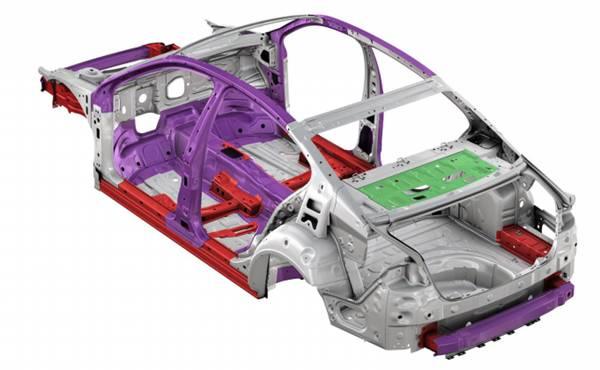Is there no lightweight for steel framed car bodies?
Regarding the lightweight of the car body, the most impressive thing to everyone is the lightweight materials such as plastics, aluminum alloys, and carbon fiber. Major automakers and the media also attach great importance to the application of lightweight materials in body manufacturing. The civilian-grade carbon fiber body represented by the BMW i-series, and the Jaguar XFL all-aluminum body, which uses aluminum to the extreme, all play with new materials.
Although the new materials are dazzling, some friends may want to ask, is there no lightening of the traditional steel frame body with "starlight dim"?
The answer is of course no. Compared with the new material body that can attract the public's attention as soon as it goes on the market, the big boy next door who is not very good at self-expression is probably already crying in the toilet.
Having said that, if everyone is looking at the future, who will take care of the present? As the most widely used steel frame car body today, it deserves everyone's attention. Today, Che Jujun is here to talk to you about the types of steel used in the steel frame body and what are the lightweight methods.
1.The same is steel, but steel is different
Automobile steel mainly involves low-strength steel (yield strength less than 210MPa), high-strength steel (yield strength between 210MPa and 550MPa), and ultra-high strength steel (yield strength greater than 550MPa). Due to the different forming, welding and use parts, low-strength steel and high-strength steel (including ultra-high-strength steel) will have certain differences in lightweight means.
2.Lightweight means of low-strength steel
With the advancement of manufacturing technology and usage concepts, low-strength steel gradually withdrew from the structural areas with higher mechanical performance requirements, and instead concentrated on components with lower mechanical performance requirements. As for the lightweight means of this kind of parts, it is mainly through analysis and optimization design methods to improve the structure of the parts.
For example, we can often see many hole structures in the white body, in addition to drainage holes, positioning holes, wiring harness holes and other functional holes, which also include a large number of weight reduction holes. In addition to the advantages of weight reduction, this hole also has the function of optimizing the force distribution and improving the body's NVH.
In addition, the integration, miniaturization, and bionics of parts are also common technical means. The best integration of components and miniaturization is undoubtedly electronic products. A lot of audio-visual and communication equipment more than ten years ago are now highly integrated on a smart phone.
Similarly, the lightweight of automobiles also adopts this effective method to unify many parts into one part, which not only saves production costs, but also achieves lightweight, killing two birds with one stone.
There is no need to say more about the examples of body integration and miniaturization. From a general perspective, the load-bearing body itself used by cars is the crystallization of integration and miniaturization; specifically, one-time molded parts such as car doors are more representative Example too.
In some respects, the structure of the car is very similar to the structure of the human body, and each component has a certain purpose. We know that the human body's bones and muscle structures are different in different areas. For example, the bones of the lower limbs will be thicker, and the upper limbs will be more flexible. These are produced in response to different purposes.
The same is true for automobiles. The quality of the parts is optimized through the bionic design of the parts. The materials are stored in the high-load parts and the materials are removed in the low-load parts, so that the quality is in the best position and the service life of the parts can be extended.
Although manufacturers are gradually increasing the proportion of high-strength steel used, the body as a whole has different forces in various regions. Although high-strength steel can increase the strength of the car body, the cost will increase invisibly. Therefore, low-carbon steel is still worth studying in areas with low strength requirements or small non-structural parts.
3.Lightweight means of high-strength steel
The application of high-strength steel in automobiles can be described as a double-edged sword. The improvement of mechanical properties also brings increased costs and manufacturing difficulties. For these reasons, high-strength steel is mainly used to make body outer panels and inner body panels. Board and body structure.
The lightweight of the body structure is based on the premise of not losing the safety of the original body and the performance of the whole vehicle. Taking into account the characteristics of high-strength steel, the lightweight of this material is mainly through advanced forming (hydroforming, hot stamping, Roll forming, etc.) and welding technology (laser welding, friction welding, etc.) to reduce the amount of steel used and meet the requirements of thinner steel production.
Optimizing front and rear thickness of steel plate of a certain car
Here, take the hot stamping forming technology as an example. This technology uses a method of heating the blank to a certain temperature and then stamping and forming in the corresponding mold with a stamping machine. It can effectively increase the strength of body parts (up to 1500MPa), reduce the weight of parts (about 20%), improve the feasibility of stamping and forming of parts (elongation rate can reach 70%) and effectively control the springback (rebound force) of parts More than 90% less reliable).
4.Which steel structure body design is better?
To ask which one is strong in steel structure body design, the editor here provides you with a few key metrics:
▎Light weight: reduce the weight of the vehicle under the premise of ensuring the requirements of the vehicle body;
▎Use of high-strength steel: The mechanical properties of the material itself are the prerequisite for safety;
▎Collapse energy absorption: Although the design of collapse energy absorption structure is still criticized by some friends, it is undeniable that this type of structure has become a trend;
▎ Dispersion of force: How to disperse the force cleverly during collision is the essence;
▎Integration, small size, and strong biomimetic capabilities: application of various integrated molding technologies and analysis and optimization technologies;
▎Frame safety structure design: For example, the frame-type body structure has the advantages of light weight, reasonable structure and high safety.
For example, Toyota GOA body (collapsible body design), Mazda's MAGMG body (also known as 3H body, which is currently used very frequently), Chery's 3R body body (the force on the body can be quickly distributed to the whole body), Audi The AFS body (although aluminum alloy is used, the space frame structure of the body is the biggest highlight), Volvo's high-strength steel body (the use rate of high-strength boron steel is more than 40%, which is a strong guarantee for safety).
5.Steel structure body is still the main force
Some friends here may have questions. Shouldn't it be the age when all kinds of new materials are popular? Is there still a need for research on traditional steel frame car bodies? Just like the question about the lightweight of the steel frame body at the beginning, this is of course necessary, and everyone must not be blindsided.
In terms of steel utilization rate, the current utilization rate of steel materials in passenger cars is about 60%, while the utilization rate in commercial vehicles is even higher, about 80%.
After comprehensively considering stiffness, strength, repairability, recyclability and cost issues, we will find that steel is still the most comprehensive. In addition, high-strength steel, also known as one of the new materials, still occupies a great advantage over other new materials in terms of coverage and stability.
In other words, high-strength steel is developed from the technological foundation of traditional steel in hand, and has obvious advantages in automobile manufacturing, which is known for its strict cost control. Coupled with the application of various modern analysis techniques, there is still room for development in the lightweight of steel framed car bodies, including the improvement of the mechanical properties of steel materials, the improvement of processing performance, and the improvement of welding methods.








